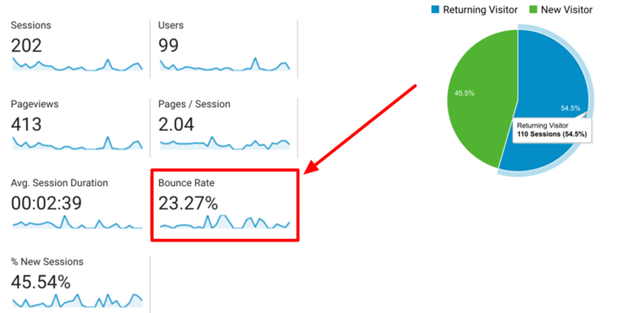Bounce rate is a key metric that measures the percentage of visitors to a website who leave after only viewing one page. This metric is important for website owners to track and understand because it can provide valuable insights into how well a website is meeting the needs of its visitors. A high bounce rate can indicate that a website is not engaging visitors and providing them with the information or resources they were looking for. This can lead to decreased conversions, fewer repeat visitors, and lower search engine rankings.

Bounce rate is affected by many different factors, including website design, content quality, and user experience. Website owners must be aware of these factors and take steps to optimize their websites in order to keep bounce rate low. In this article, we will explore the top 10 factors that can affect bounce rate and provide tips on how to fix them.
Understanding bounce rate and taking steps to reduce it can help website owners improve the performance of their website, increase conversions, and ultimately drive more revenue. By taking the time to identify and address the factors that are causing high bounce rate on a website, website owners can create a more engaging and user-friendly experience for their visitors.

Factor 1: Slow loading speed
One of the most important factors that can affect bounce rate is website loading speed. Visitors are less likely to stick around on a website that takes too long to load, and search engines also take loading speed into consideration when determining search engine rankings. To improve website speed, consider optimizing images like compressing images, minimizing the use of large videos and heavy coding, and using a content delivery network (CDN).
Factor 2: Poor website design
Another major factor that can affect bounce rate is poor website design. Visitors are more likely to leave a website if it is difficult to navigate, unattractive, or outdated. To improve website design, consider using a clear layout, consistent branding, and easy-to-use navigation. Additionally, consider using a responsive design that adjusts to different screen sizes and devices.
Factor 3: Lack of clear call to action
A lack of a clear call to action can lead to confusion for visitors, causing them to quickly leave a website. A call to action is an instruction to the visitor to take a specific action, such as making a purchase or signing up for a newsletter. To improve the effectiveness of calls to action, make them prominent and easy to find, use action-oriented language, and provide a sense of urgency.
Factor 4: Unrelevant or low-quality content
Visitors are more likely to leave a website if the content is irrelevant or of low quality. To improve the quality of website content, consider conducting keyword research to determine what topics are most important to your target audience, and use those keywords in your content. Additionally, consider using subheadings, bullet points, and images to break up text and make it more visually appealing.
Factor 5: Complex navigation
Complex navigation can make it difficult for visitors to find what they are looking for, causing them to quickly leave a website. To improve navigation, consider using a simple, intuitive navigation menu and including a search bar. Additionally, consider using breadcrumb navigation to show visitors where they are on the website and how to get back to previous pages.
Factor 6: Pop-ups and other intrusive elements
Pop-ups and other intrusive elements can be disruptive to visitors and lead to a higher bounce rate. To minimize their use, consider using them sparingly, only displaying them when necessary, and providing an easy way for visitors to close them.
Factor 7: Mobile responsiveness
More and more visitors are using mobile devices to access websites, and a lack of mobile responsiveness can lead to a poor user experience, causing visitors to quickly leave. To make a website mobile-friendly, consider using a responsive design that automatically adjusts to different screen sizes and devices, and consider using larger fonts and larger buttons to make it easier for visitors to tap on links with their fingers.
Factor 8: Broken links
Broken links can be frustrating for visitors, causing them to quickly leave a website. To fix broken links, consider regularly checking for broken links and fixing them as soon as they are discovered. Additionally, consider using a tool that automatically checks for broken links.
In conclusion, bounce rate is a crucial metric for website owners to track and understand. It provides valuable insights into how well a website is meeting the needs of its visitors and can indicate areas where the website can be improved. Understanding the top 10 factors that can affect bounce rate and taking steps to optimize a website for these factors can help website owners improve the performance of their website and ultimately drive more revenue.
Website owners must be aware of the factors that can affect bounce rate, such as slow loading speed, poor website design, lack of clear call to action, irrelevant or low-quality content, complex navigation, pop-ups and other intrusive elements, mobile responsiveness, and broken links. By identifying and addressing these factors, website owners can create a more engaging and user-friendly experience for their visitors, which can lead to increased conversions and repeat visitors.
Additionally, it is important to track and monitor your website’s bounce rate over time to see if the changes made are effective. Continuously testing and optimizing your website is the key to achieve a lower bounce rate. Moreover, it’s also important to consider the industry standards and compare your website’s bounce rate with the average of your industry.
In summary, bounce rate is a key metric that website owners should pay attention to and take steps to optimize. And, as a digital agency, we understand the importance of factors that can affect bounce rate and taking action to address them. That’s why website owners must work on all these factors to improve the performance of their website and drive more revenue.



